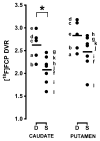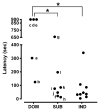Differences in D2 dopamine receptor availability and reaction to novelty in socially housed male monkeys during abstinence from cocaine
- PMID: 20066401
- PMCID: PMC2891780
- DOI: 10.1007/s00213-009-1756-4
Differences in D2 dopamine receptor availability and reaction to novelty in socially housed male monkeys during abstinence from cocaine
Abstract
Rationale: Studies in socially housed monkeys have demonstrated an influence of position in the social dominance hierarchy on brain dopamine D2 receptors and the reinforcing effects of cocaine that dissipates after long-term cocaine self-administration.
Objective: The aims of the study were to examine the effects of abstinence from cocaine on D2 receptors in socially housed monkeys and to extend behavioral characterizations to measures of reactivity to a novel object.
Materials and methods: Twelve socially housed male cynomolgus monkeys with extensive cocaine self-administration experience were used (average lifetime intakes ∼270 and 215 mg/kg for dominant and subordinate monkeys, respectively). Abstinence lasted for approximately 8 months, after which D2 receptor availability was assessed using positron emission tomography and the D2 ligand [18F]fluoroclebopride. Reaction to novelty was also assessed in these subjects as well as nine individually housed monkeys.
Results: During abstinence, D2 receptor availability in the caudate nucleus was significantly higher in dominant versus subordinate monkeys. Average latency to touch a novel object was also significantly higher in dominant monkeys compared to subordinates or individually housed monkeys. In socially experienced monkeys, a significant positive correlation was observed between caudate nucleus D2 receptor availability and latencies to touch the novel object.
Conclusions: Although chronic cocaine self-administration blunts the ability of social dominance to alter D2 receptor availability and sensitivity to the reinforcing effects of cocaine, this influence reemerges during abstinence. In addition, the data suggest that prior experience with social dominance can lead to longer latencies in reaction to novelty--a personality trait associated with low vulnerability to cocaine abuse.
Figures



Similar articles
-
Effects of social reorganization on dopamine D2/D3 receptor availability and cocaine self-administration in male cynomolgus monkeys.Psychopharmacology (Berl). 2017 Sep;234(18):2673-2682. doi: 10.1007/s00213-017-4658-x. Epub 2017 Jun 12. Psychopharmacology (Berl). 2017. PMID: 28608008 Free PMC article.
-
Social dominance in female monkeys: dopamine receptor function and cocaine reinforcement.Biol Psychiatry. 2012 Sep 1;72(5):414-21. doi: 10.1016/j.biopsych.2012.03.002. Epub 2012 Apr 14. Biol Psychiatry. 2012. PMID: 22503110 Free PMC article.
-
Characterization of dopamine D1 and D2 receptor function in socially housed cynomolgus monkeys self-administering cocaine.Psychopharmacology (Berl). 2004 Jul;174(3):381-8. doi: 10.1007/s00213-003-1752-z. Epub 2004 Feb 7. Psychopharmacology (Berl). 2004. PMID: 14767632
-
PET imaging of dopamine D2 receptors in monkey models of cocaine abuse: genetic predisposition versus environmental modulation.Am J Psychiatry. 2005 Aug;162(8):1473-82. doi: 10.1176/appi.ajp.162.8.1473. Am J Psychiatry. 2005. PMID: 16055768 Review.
-
Review. Positron emission tomography imaging studies of dopamine receptors in primate models of addiction.Philos Trans R Soc Lond B Biol Sci. 2008 Oct 12;363(1507):3223-32. doi: 10.1098/rstb.2008.0092. Philos Trans R Soc Lond B Biol Sci. 2008. PMID: 18640923 Free PMC article. Review.
Cited by
-
Individual differences and social influences on the neurobehavioral pharmacology of abused drugs.Pharmacol Rev. 2013 Jan 23;65(1):255-90. doi: 10.1124/pr.111.005124. Print 2013 Jan. Pharmacol Rev. 2013. PMID: 23343975 Free PMC article. Review.
-
Dopamine in socioecological and evolutionary perspectives: implications for psychiatric disorders.Front Neurosci. 2015 Jun 16;9:219. doi: 10.3389/fnins.2015.00219. eCollection 2015. Front Neurosci. 2015. PMID: 26136653 Free PMC article.
-
Behavioral characterization of adult male and female rhesus monkeys exposed to cocaine throughout gestation.Psychopharmacology (Berl). 2011 Feb;213(4):799-808. doi: 10.1007/s00213-010-2038-x. Epub 2010 Oct 20. Psychopharmacology (Berl). 2011. PMID: 20959969 Free PMC article.
-
A preliminary study of dopamine D2/3 receptor availability and social status in healthy and cocaine dependent humans imaged with [(11)C](+)PHNO.Drug Alcohol Depend. 2015 Sep 1;154:167-73. doi: 10.1016/j.drugalcdep.2015.06.039. Epub 2015 Jun 30. Drug Alcohol Depend. 2015. PMID: 26164205 Free PMC article.
-
The Roles of Dopamine D2 Receptor in the Social Hierarchy of Rodents and Primates.Sci Rep. 2017 Feb 24;7:43348. doi: 10.1038/srep43348. Sci Rep. 2017. PMID: 28233850 Free PMC article.
References
-
- Bardo MT, Donohew RL, Harrington NG. Psychobiology of novelty seeking and drug seeking behavior. Behav Brain Res. 1996;77:23–43. - PubMed
-
- Czoty PW, Morgan D, Shannon EE, Gage HD, Nader MA. Characterization of dopamine D1 and D2 receptor function in socially housed cynomolgus monkeys self-administering cocaine. Psychopharmacology. 2004;174:381–388. - PubMed
-
- Czoty PW, Gage HD, Nader MA. PET imaging of striatal dopamine D2 receptors in nonhuman primates: increases in availability produced by chronic raclopride treatment. Synapse. 2005a;58:215–219. - PubMed
-
- Czoty PW, McCabe C, Nader MA. Assessment of the reinforcing strength of cocaine in socially housed monkeys using a choice procedure. J Pharmacol Exp Ther. 2005b;312:96–102. - PubMed
Publication types
MeSH terms
Substances
Grants and funding
LinkOut - more resources
Full Text Sources
Medical

